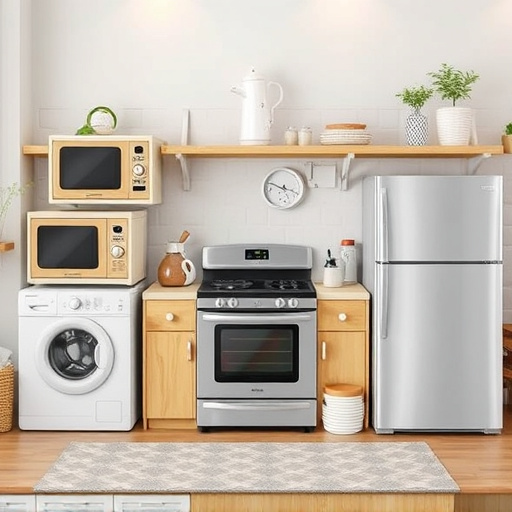Washer drain pump failures are a leading cause of flooding in major appliances, with debris buildup and worn parts being the main issues. Regular maintenance, including cleaning and checks, prevents these problems. Replacing a drain pump requires identifying the correct part for your appliance, ensuring proper sealing, and securing it with screws or clamps after disconnection from the cold water supply. Proactive measures like annual inspections, cleaning of the drain hose, and replacement of worn parts extend appliance lifespans and safeguard homes from flooding.
Washer drain pump replacements are essential in mitigating flooding incidents in major appliances. This comprehensive guide delves into the common causes of washing machine flooding, helping you identify the right replacement parts for optimal efficiency. Learn the step-by-step process of replacing a worn-out drain pump to prevent future issues. Additionally, discover maintenance tips tailored to keep your washer running seamlessly, ensuring peace of mind in your household.
- Understanding Washer Drain Pump Failures: Common Causes of Flooding in Major Appliances
- Identifying the Right Replacement Part for Your Washing Machine's Drain Pump
- Step-by-Step Guide to Efficiently Replacing a Worn-Out Drain Pump
- Maintenance Tips to Prevent Future Drain Pump Issues and Keep Your Washer Running Seamlessly
Understanding Washer Drain Pump Failures: Common Causes of Flooding in Major Appliances

Washer drain pump failures are a common cause of flooding in major appliances, leading to numerous incidents and inconveniences for homeowners. These pumps play a crucial role in removing water from the washing machine after each cycle, ensuring that excess moisture doesn’t pool at the bottom. When they malfunction or fail, it can result in a soaked laundry room floor.
The most common causes of such failures include debris buildup, which blocks the pump’s intake, and worn-out parts. Over time, the pump’s seals and gaskets may degrade, causing leaks and eventual failure. Additionally, electrical issues, such as faulty wiring or a damaged motor, can also lead to drain pump malfunctions. Regular maintenance, including cleaning the pump and checking for any signs of damage, can help prevent these failures and keep major appliances like washing machines functioning smoothly.
Identifying the Right Replacement Part for Your Washing Machine's Drain Pump

When it comes to replacing your washing machine’s drain pump, identifying the right part is crucial for preventing future flooding incidents. The first step is to determine the make and model of your appliance. Major appliances often have serial numbers or identification tags that can be referenced for specific replacement parts. Online retailers and manufacturers’ websites typically offer detailed part diagrams, allowing you to match the correct drain pump to your machine.
Additionally, considering the pump’s capacity and functionality is essential. Drain pumps come in various sizes and types, designed for different washing machine capacities and water flow rates. Ensuring a proper fit and optimal performance will prevent clogs and leaks, keeping your home dry and safe from potential water damage caused by a malfunctioning drain pump.
Step-by-Step Guide to Efficiently Replacing a Worn-Out Drain Pump

Replacing a worn-out drain pump in your washer is a straightforward process that can prevent flooding incidents and prolong the life of your major appliances. Here’s a step-by-step guide to efficiently accomplishing this task:
1. Safety First: Unplug the washing machine from its power source for safety reasons. Ensure no water remains in the pipes by opening the cold water supply valve at the back of the machine. This step is crucial, as it prevents electrical shocks and potential water damage during the replacement process.
2. Access the Pump: Locate the pump at the bottom of your washer. It’s usually attached to a flexible hose that connects to the drain pipe. Use a flathead screwdriver or wrench to carefully loosen and remove any securing screws or clamps holding the pump in place. Set them aside for future reference if you plan to reattach the pump after replacement.
3. Remove the Old Pump: Pull the old pump out of its housing. Depending on your machine, there might be additional clamps or hooks securing it. Release these and discard the worn-out pump responsibly, ensuring no parts fall into the washer or drain pipe.
4. Install the New Pump: Take the new pump and align it with the opening in the washer. Secure it using the screws or clamps that were removed earlier. Ensure all connections are tight but not overly forced to prevent damage.
5. Reattach and Test: Reconnect the flexible hose to the new pump, ensuring a secure fit. Plug in your washing machine and turn on the cold water supply valve. Operate the machine through a test cycle to verify that the drain pump is functioning correctly and there’s no leaking or flooding.
Maintenance Tips to Prevent Future Drain Pump Issues and Keep Your Washer Running Seamlessly

Regular maintenance is key to preventing future drain pump issues and keeping your washer running seamlessly. Start by ensuring proper drainage by checking and cleaning the wash machine’s drain hose annually. A simple yet effective step is to remove the hose during the off-season, clean it thoroughly, and inspect for any signs of damage or wear. This process eliminates buildup and debris that can clog the line over time. Additionally, consider using a drain cleaning product designed for major appliances to clear out any residual blockages.
Another crucial maintenance tip involves inspecting and replacing worn-out parts, such as the washer’s impeller or pump. Over time, these components can degrade, leading to reduced water flow and increased pressure, which may cause flooding. Regularly checking for wear and tear during your annual cleaning routine will help you identify these issues early on. Remember, taking proactive measures not only saves you from costly repairs but also prevents potential flooding incidents, keeping your home safe and your major appliances in top condition.
Washer drain pump replacements are an effective solution to prevent flooding incidents in major appliances. By understanding common failure causes, selecting the right replacement part, and following a step-by-step guide for efficient installation, you can ensure your washing machine operates seamlessly. Regular maintenance tips, such as cleaning filters and preventing debris buildup, further safeguard against future drain pump issues, keeping your washer running smoothly and flooding at bay.
